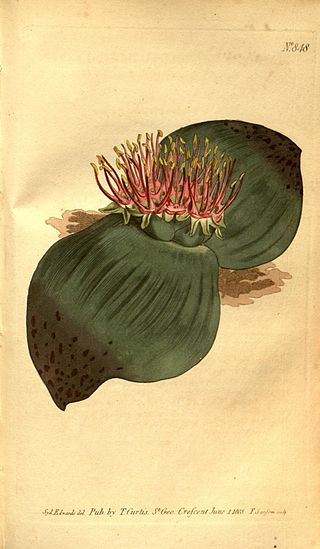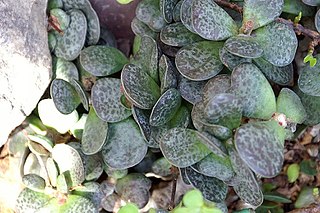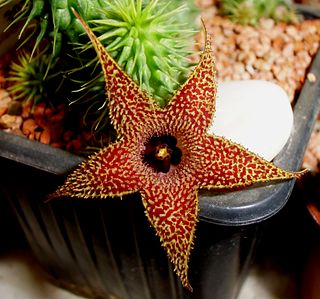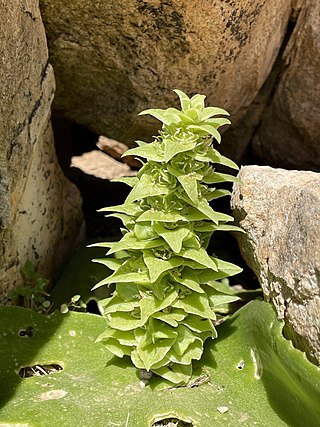
Osteospermum, is a genus of flowering plants belonging to the Calenduleae, one of the smaller tribes of the sunflower/daisy family Asteraceae. They are known as the daisybushes or African daisies.

Spartium junceum, known as Spanish broom, rush broom, or weaver's broom, it is a species of flowering plant in the family Fabaceae and the sole species in the genus Spartium. It is closely related to the other brooms.

Deschampsia cespitosa, commonly known as tufted hairgrass or tussock grass, is a perennial tufted plant in the grass family Poaceae. Distribution of this species is widespread including the eastern and western coasts of North America, parts of South America, Eurasia and Australia.

Allium cristophii, the Persian onion or star of Persia, is a species of flowering plant in the family Amaryllidaceae, native to Iran, Turkey, and Turkmenistan, though grown as an ornamental bulbous plant in many parts of the world. It may be sold under the synonym of Allium albopilosum.

Haemanthus coccineus, the blood flower, blood lily or paintbrush lily, is a species of flowering plant in the amaryllis family Amaryllidaceae, native to Southern Africa. Growing to 35 cm (14 in) tall and wide, it is a bulbous perennial with short brown stems surmounted by red flowers, the flowers appearing in spring and summer, before the strap-shaped leaves.

Oscularia deltoides, the deltoid-leaved dewplant, dassievygie or sandsteenvygie is a species of flowering succulent plant in the fig-marigold family Aizoaceae that is native to the south-western Cape, South Africa.

Linnaea chinensis, commonly known as Chinese abelia, is a species of flowering plant in the honeysuckle family Caprifoliaceae. It is a semi-evergreen, densely branched shrub with dark green foliage.

Massonia pustulata, the blistered massonia, is a species of flowering plant in the family Asparagaceae, subfamily Scilloidiae, native to the Western Cape of South Africa. Growing to 10 cm (3.9 in) tall and broad, it is a small bulbous perennial with two horizontal, opposite leaves, and virtually stalkless cream or pink flowers in winter. The stamens are longer than the perianth, giving the flower the appearance of a rounded, spiky brush-head. The deep “pock marks” on the leaves give the plant its common name, as well as the specific epithet pustulata.

Massonia depressa, the hedgehog lily, is a species of flowering plant in the family Asparagaceae. It is a bulbous geophyte native to the Cape Provinces and Free State of South Africa. Growing to 10 cm (3.9 in) tall by 50 cm (20 in) broad, it is a bulbous perennial with two opposite leaves lying flat on the ground. A spiky cluster of white, yellow or brown flowers appears at the centre of the plant in winter. The flowers are uniquely scented like yeast, to attract pollination by gerbils and other rodents. The anther is exceptionally long - up to 2mm. The seed capsules are inflated, enabling them to be wind-borne.

Adromischus maculatus, the spotted adromischus or calico hearts, is a species of flowering plant in the family Crassulaceae, which is endemic to the Eastern Cape and Western Cape of South Africa.

Lachenalia viridiflora, commonly known as the green-flowered Cape cowslip or turquoise hyacinth, is a species of flowering plant in the asparagus family native to the southwest Cape Provinces of South Africa. It was discovered in the 1960s, and first described in 1972 by Winsome Fanny Barker.

Carpanthea pomeridiana, the afternoon carpanthea, is a species of flowering plant in the genus Carpanthea, native to the western Cape Provinces of South Africa, and introduced to New South Wales, Australia. It has gained the Royal Horticultural Society's Award of Garden Merit as an ornamental.

Huernia pillansii, called the cocklebur, is a species of flowering plant in the genus Huernia, native to the Cape Provinces of South Africa. A succulent, it has gained the Royal Horticultural Society's Award of Garden Merit as a hothouse ornamental.

Rhodocoma capensis, called the Cape restio, is a species of reed-like perennial grass in the family Restionaceae, native to the southwestern Cape Provinces of South Africa. Growing over 2 m tall, with clumping, jointed stems, it has gained the Royal Horticultural Society's Award of Garden Merit as an ornamental, suitable for borders and architectural applications.
Tulbaghia leucantha, the mountain wild garlic, is a species of flowering plant in the family Amaryllidaceae, widely distributed in southern Africa. It has gained the Royal Horticultural Society's Award of Garden Merit as an ornamental.

Elegia equisetacea, the horsetail restio or broom reed, is a species of reed‑like flowering plant in the family Restionaceae, native to the southwestern Cape Provinces of South Africa. It has gained the Royal Horticultural Society's Award of Garden Merit as an ornamental.
Elegia elephantina, the large Cape rush, is a species of reed‑like flowering plant in the family Restionaceae, native to the western Cape Provinces of South Africa. It has gained the Royal Horticultural Society's Award of Garden Merit as an ornamental.
Stomatium alboroseum is a species of succulent plant in the family Aizoaceae, native to the Cape Provinces of South Africa. Under its synonym Stomatium niveum it has gained the Royal Horticultural Society's Award of Garden Merit.

Jarava plumosa is a species of grass in the family Poaceae, native to the Southern Cone of South America. It has been introduced to other places with a Mediterranean climate; California, Spain, Israel, the Cape Provinces of South Africa, and South Australia. As its synonym Stipa papposa it has gained the Royal Horticultural Society's Award of Garden Merit as an ornamental in spite of its invasive potential.

Massonia bifolia is a species of geophyte in the genus Massonia. It is native to southern Namibia and to the western Cape Provinces of South Africa.
















